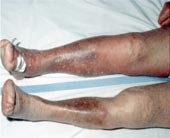Peer Reviewed
Feature Article Haematology
The insidious hazard of hospitalisation: venous thromboembolism
Abstract
Symptomatic venous thromboembolism (VTE) is a leading cause of death after admission to hospital. Recognition of when to act before and after patients are admitted to hospital with VTE will help prevent mortality and morbidity.
Key Points
- Symptomatic venous thromboembolism (VTE) is estimated to be responsible for 7% of all hospital deaths and more than 15,000 hospitalisations in Australia annually.
- Long-term sequelae of VTE often seen in general practice are pernicious, with significant numbers of patients experiencing the post-thrombotic syndrome and many being debilitated with chronic venous ulceration.
- In hospital, VTE risk assessment is often not undertaken and only 60% of patients receive appropriate VTE prophylaxis.
- Two main types of VTE prophylaxis have been shown to be effective: pharmaceutical agents and mechanical devices.
- VTE prophylaxis guidelines are available to assist with VTE risk assessment and to tailor appropriate treatment and duration of treatment to the patient’s level of VTE risk.
- Knowledge of the current VTE guidelines will help GPs to facilitate community-based VTE prophylaxis and, for those with hospital-admitting rights, to care for their hospitalised patients.
Purchase the PDF version of this article
Already a subscriber? Login here.

